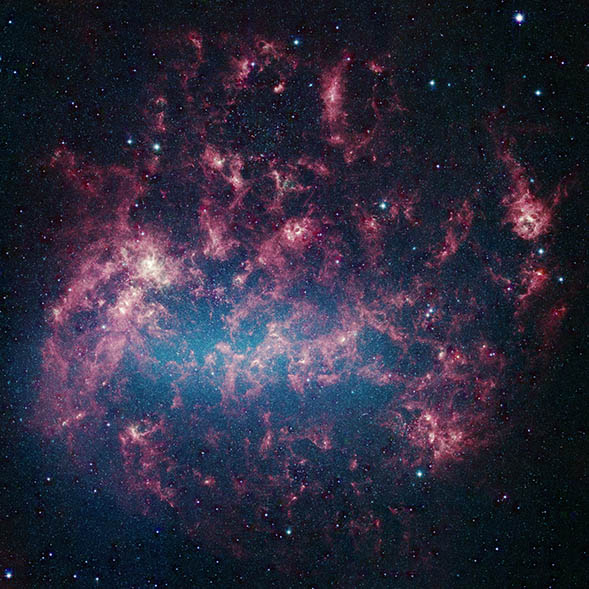







| BOOKS | F. A. Q. | ARTICLES | TALKS | ABOUT KEN | DONATE | BEYOND OUR KEN |
|---|
By Ken Croswell
Published on ScienceNOW (June 25, 2011)

The Large Magellanic Cloud stole stars from its neighbor. Credit: Spitzer Space Telescope. NASA/JPL-Caltech/M. Meixner (STScI) and the SAGE Legacy Team.
It's as though the king stole some of the prince's jewels. Astronomers say the brightest galaxy orbiting our Milky Way likely seized millions of stars from the second brightest. Both satellite galaxies resemble the ones that smashed together long ago to create giant galaxies like our own, so the discovery helps illuminate how such galactic building blocks formed and evolved.
Lying just 160,000 light-years from Earth, the Large Magellanic Cloud is by far the brightest of the two dozen or so galaxies orbiting the Milky Way. The galaxy is 1/10 as luminous as ours and harbors 1/100 as much mass.
Astronomer Knut Olsen of the National Optical Astronomy Observatory in Tucson, Arizona, and his colleagues observed thousands of stars in the Large Magellanic Cloud. Most were orange and red giants--aging stars that are larger, brighter, and cooler than the Sun.
"About 5 percent of the stars had very peculiar velocities," Olsen says. "We were definitely surprised. I hadn't expected anything like this at all." The velocities indicate that the stars don't orbit the center of the Large Magellanic Cloud in the same direction as their peers. Instead, the stars revolve either backward or at an approximately 54-degree tilt to the galaxy's main body.
Furthermore, the wayward stars don't share their home galaxy's chemical composition. Their iron abundance matches that of the Small Magellanic Cloud, the Milky Way's second brightest satellite galaxy, located 200,000 light-years from Earth and 75,000 light-years from the Large Magellanic Cloud. As Olsen's team will report in a future issue of The Astrophysical Journal, the Large Magellanic Cloud probably stole 5 percent of its stars from its smaller sibling.
"I'm very excited about this work," says astronomer Gurtina Besla of the Harvard-Smithsonian Center for Astrophysics in Cambridge, Massachusetts, who thinks the Magellanic Clouds have long revolved around each other on an elliptical orbit. "Every time the Small Magellanic Cloud comes close to the Large Magellanic Cloud, the Large Magellanic Cloud's gravitational tides strip out stars and gas." Besla says the discovery supports her view that the two galaxies owe their structure more to each other than they do to effects from the Milky Way.
Olsen says the stars share the motion of gas streams near the Large Magellanic Cloud, suggesting that the galaxy tore not only stars but also gas from its lesser neighbor. If so, that could explain a long-standing mystery. Although smaller than the Milky Way, the Large Magellanic Cloud boasts something our own Galaxy can't match: its greatest star-forming region, named 30 Doradus, spans 700 light-years--28 times the size of the Orion Nebula, the best-known stellar nursery in the Milky Way. Olsen thinks the infalling gas hit 30 Doradus, causing it to grow large and luminous by fueling the formation of new stars.
Ken Croswell is an astronomer and the author of The Lives of Stars.
"A stellar picture of what we know or guess about those distant lights."--Kirkus. See all reviews of The Lives of Stars here.
| BOOKS | F. A. Q. | ARTICLES | TALKS | ABOUT KEN | DONATE | BEYOND OUR KEN |
|---|